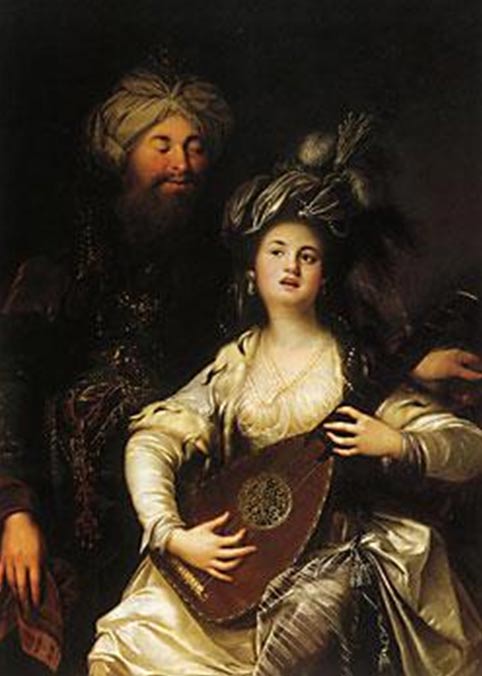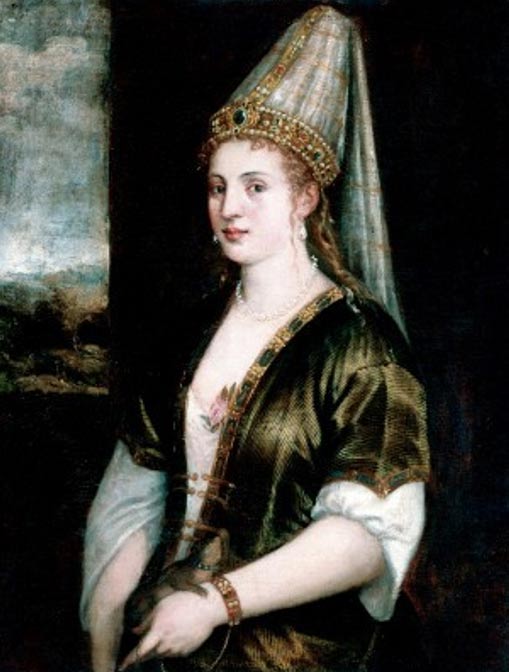
Hurrem Sultan, the Cheerful Rose of Suleiman I and a Powerful Woman of the Ottoman Empire
Hürrem Sultan appeared in Topkapi Palace as a slave, but in a very short time she became one the most influential women of the Ottoman Empire. The name Hürrem was given her by the Sultan Suleiman I, and means “the cheerful one”- but in the eyes of many of her rivals she was the most dangerous weapon in Constantinople’s armory.
Suleiman Meets Hürrem
From 1520-1566, the Ottoman Empire was ruled by Suleiman I, who many claim was the greatest Sultan in history. He was also known as Suleiman the Magnificent or Kanuni – The Lawgiver. During his time in power, he made an impact on the history of many countries in Europe and the Middle East.

Portrait of Suleiman I, the tenth and longest reigning Sultan of the Ottoman Empire. (1530) By Titian. (Public Domain)
Suleiman’s life took a radical change in 1520. In September of that year, his father Selim I passed away accidentally, and with his death, Suleiman’s carefree life in the Manisa province came to an end. He was called to the capital city to rule the empire. At the same time, he met the woman who would forever change his life.
History has remembered her as Roxolena or Roksolana, Roxalene, Roxolane, and Rossa. However, the name she was called for most of her life is Hürrem. She received this name due to her cheerful personality.
Hürrem was born as Alexandra Lisowska in the town of Rohatyń, 68 km (42.3 miles) southeast of Lwów in the Crown of the Kingdom of Poland (today in Western Ukraine). In the 1520s Crimean Tatars captured her during one of their raids in this region. They took her as a slave to a major center of the slave trade in the Crimean city of Kaffa. Then she was transported to Constantinople and selected for the harem.
Hürrem’s influence on Suleiman was almost immediate - it only took a few months from the day that she met Sultan Suleiman to the moment when she became the most important consort in the harem.
Due to her beauty and intelligence she quickly came to the attention of the Sultan. At the same moment she attracted the jealousy of her rivals in the harem, including Mahidevran Sultan, mother of the heir apparent Mustafa. Historians note that these rivalries led to a few attempts to take Hürrem’s life. The most famous is Mahidevran's attack on Hürrem, which was followed by Suleiman banishing his former favorite, and her son, to the provincial capital of Manisa.

Roxelane und der Sultan (Roxolena and the Sultan). (1780) by Anton Hickel. (Public Domain)
The Ruthenian Witch
The bond between Hürrem and Suleiman was more than unexpected for the society of the time. Their close relationship became the first time in the history of the dynasty when the sultan focused on only one woman. Hürrem’s influence over the Sultan soon became legendary. She gave him six children: Sehzade Mehmed, Mihrimah Sultan, Sehzade Abdullah, Selim II, Sehzade Beyazit and Sehzade Cihangir.
This strengthened her position in the palace so much that she initiated a new order in the harem. Since her arrival to Topkapi Palace, she was sure to take as many lessons as she could. From her studies she learned the Ottoman language, mathematics, astronomy, geography, diplomacy, literature, and history. Apart from this, she was very interested in alchemy. During the excavations in the Edirne Palace some of her tools for preparation of perfumes were discovered.
- Long-Lost Tomb Belonging to Suleiman the Magnificent Believed to be Found
- Theodora: From humble beginnings to powerful empress who changed history
- Secrets of the Hagia Sophia - Healing Powers, Mysterious Mosaics and Holy Relics
Due to her excellent education, she also became Suleiman’s adviser on matters of the state. Hürrem had an influence upon foreign affairs and international politics. For example, she took care of maintaining the peaceful relations between the Ottoman Empire and Polish state with a Polish-Ottoman alliance. According to Crimean historians, she also intervened to control Crimean Tatar slave-raiding.

Letter from Hürrem to Sigismond Auguste complimenting him upon his acsending to the Polish throne (1549). (Public Domain)
In spite of her various positive aspects, for other advisers of Suleiman the position of Hürrem was too high for a woman. They started to believe that she must be a witch who put a spell on the Sultan and began to spread rumors about her. When Suleiman discovered these stories, he punished everyone who repeated the negative tales about his love.
More Than a Haseki
Haseki was the title given to the chief consort of the Ottoman Sultan. The title was created in the16th century and Hürrem Sultan was the first holder of this title. But this standing did not satisfy the ambitious and demanding woman. According to the French writer and historian Fontenelle, she decided that she had to find a way to marry Suleiman.
First, she asked to be instructed in the Muslim religion. Suleiman saw no objection and took care of her religious education. Once instructed, she told him she wished to become a Muslim. Converting her from Christian Orthodox to Islam made the Sultan so happy that he decided to free her.
After the conversion ceremony, Hurrem declared that her new religion would not allow her to have a sexual relationship with a man she was not married to. According to Ottoman historiographers her plan worked - Suleiman resisted three days, then married her.

La Sultana Rossa (c. 1550s) by Titian. (Public Domain)
Poems to The Polish Rose
Suleiman was not only a sultan, but a poet. Many of his poems are dedicated to Hürrem after she became his wife. He signed these poems as "Muhibbi," meaning "lover" or "sweetheart." This is one example of a poem he wrote:
Throne of my lonely niche, my wealth, my love, my moonlight.
My most sincere friend, my confidant, my very existence, my Sultan, my one and only love.
The most beautiful among the beautiful...
My springtime, my merry faced love, my daytime, my sweetheart, laughing leaf...
My plants, my sweet, my rose, the one only who does not distress me in this world...
My Istanbul, my Caraman, the earth of my Anatolia
My Badakhshan, my Baghdad and Khorasan
My woman of the beautiful hair, my love of the slanted brow, my love of eyes full of mischief...
I'll sing your praises always
I, lover of the tormented heart, Muhibbi of the eyes full of tears, I am happy.
- Archaeologists search for ‘lost heart’ of Suleiman the Magnificent
- Caterina Sforza: A Renaissance Warrior Woman That Knew How to Get What She Wanted
- How the Sultan Moulay Ismail of Morocco Sired 1,000 Children
A Philanthropist
Apart from her political interests, Hürrem was a great philanthropist. She engaged in several major works of public buildings. Her first works were two Koranic schools, fountains, several mosques, and a women’s hospital near the women’s slave market of Avret Pazary in Constantinople.
She also commissioned a bath, the Haseki Hürrem Sultan Hamam, to serve the community of worshipers in the nearby Hagia Sophia and Suleiman's mosque. This Hamam continues to function today. In 1552, she went on to establish the Hasseki Sultan Imaret in Jerusalem. This was a public soup kitchen to feed the 500 poor and the needy people twice per day.

The Haseki Hürrem Sultan Hamam. Istanbul, Turkey. (Public Domain)
The Death of a Sultan's Wife
Hürrem died on April 15, 1558 of an unknown illness. Suleiman buried her in a mausoleum which belongs to the complex of Suleiman's mosque. He joined her 8 years later - finding his final resting place in the same complex.

The türbe (mausoleum) of Hürrem Sultan in Suleiman Mosque at Fatih, Istanbul, Turkey. (CC BY SA 2.5)
Hürrem is remembered for her social work and as the woman to whom Suleiman was faithful. She was also noted to have performed many schemes and was ready to do anything to protect her family. After Suleiman died, her son Selim ascended the throne. He ruled the Ottoman Empire until his death on December 15, 1574.
Featured Image: Rosa Solymanni uxor. (16th century). Source: Public Domain
By: Natalia
References
Catherine Clement, Hürrem Sultan, 2011
Andre Colt, Suleiman the Magnificent, 2012
Galina I. Yermolenko, Avrupa Edebiyati, Tarihi ve Kulturunde Hurrem Sultan, 2013
Yavuz Bahadiroglu, Muhtesem Kanuni Sultan Suleyman ve Hurrem Sultan, 2013
Erhan Afyoncu, Muhtesem Suleyman. Kanuni Sultan Suleyma ve Hurrem Sultan, 2011















Comments
I support Hurrem....:p she was really a witch....hmn
Great stuff and well written!
malisa wright
Was she not Russian?
He fell in love with a Polish girl. Been there, done that.
Very radical I agree with you some people don't know history this was the way of the world and by comparison these people were kind and noble
Pages